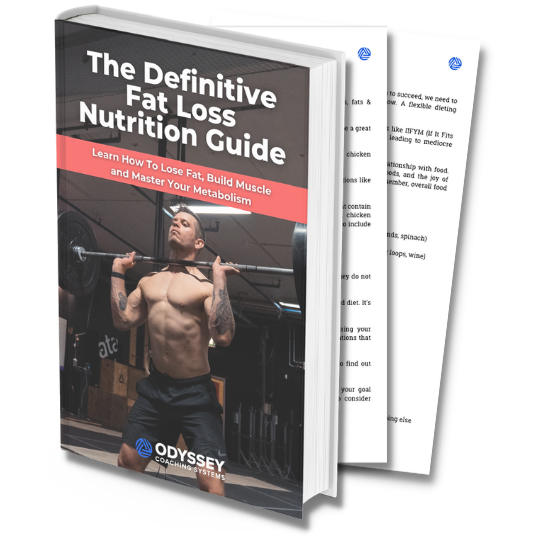Main Take-Aways
1. In Layman’s Terms, Thermic Effect of Food (TEF) stands for the calories burned by your digestive system. Your body breaks down food, absorbs and stores nutrients, and you burn off some energy (calories) as heat.
2. Personal preference and daily schedule are the two most important factors to base your meal frequency on. At the end of the day it’s about what you can stick to consistently on a daily basis.
3. Having a consistent eating schedule has been shown to improve digestion, insulin sensitivity, lead to more stable blood sugar, increase energy expenditure, and more.
The thermic effect of food (TEF) refers to the increase in metabolism after eating a meal.
Now you might’ve heard that eating frequent small meals throughout the day ‘stokes the metabolism’ or ‘keeps your metabolic fire burning’.
But is that really true?
In this article you’ll learn all about the thermic effect of food, how you can influence it, if eating small meals stokes the metabolism, how often to eat for your goals, and lastly what the science says about having a consistent eating schedule.
What is ‘Thermic effect of food’?
In Layman’s Terms, Thermic Effect of Food (TEF) stands for the calories burned by your digestive system. Your body breaks down food, absorbs and stores nutrients, and you burn off some energy (calories) as heat.
On average, that thermic effect accounts for 10% of your daily calories burned [1].
⇒ Read more about your Total Daily Energy Expenditure.
That means that part of the calories you get from the food you eat, already gets burned off just by digesting that food.
People will often bring this up when they claim that “a calorie is not a calorie”. However this is false, and a calorie is most definitely a calorie.
The thing is that both the ‘calories in’ and ‘calories out’ side of energy balance are interconnected. In this scenario the energy coming in from food (calories in ↑) leads to an increase in TEF (calories out ↑).
Now here’s the cool thing: you can influence the Thermic Effect of Food by adjusting your diet.
- Protein has a thermic effect of 20-30% (!!!)
- Carbs have a thermic effect of 5-10%
- Fats have a thermic effect of 0-3%
This is one of the reasons why a high-protein diet can be beneficial, especially in a weight loss phase.
⇒ Read more about the benefits of protein, or click here for the definitive protein cheat sheet.

Does eating small frequent meals stoke the metabolism?
Let’s do some myth-busting, shall we?
The thought makes sense, because there is an increase in your metabolism after eating a meal. So that must mean that the more often you eat, the more you’ll keep the metabolism burning.. Right?
In the meantime we hear about bodybuilders eating many meals throughout the day. Hmm..
Then the supplement industry catches wind and jumps on this claim. Smart move! Because if you think that you have to keep the metabolism going, and because you’re not very likely to have a full meal right after your workout.. Then you’re going to have to get that shake, or else you miss out on some sick gains!
Turns out that grazing on tiny meals all day long does not seem to increase your metabolism after all.
You see, it’s not about how often you eat per day, but its the total amount of food, and what you eat that determines your TEF for the day.
How often to eat for your goals
So.. How many meals should you eat per day?
About 4-5 meals a day seems to be the sweet spot for most people, regardless of what phase they’re in.
This is also the meal frequency I usually recommend to my online nutrition coaching clients (especially for muscle building).
However there are some things that matter more than anything else when it comes to how many meals to eat.
And those are personal preference and your schedule.
- How often do you WANT to eat?
- How many meals can you even fit into your busy daily life?
- Does your digestion do better with smaller meals?
- Do you just enjoy bigger meals?
- How hungry/satisfied are you in between meals?
At the end of the day it’s about what you can stick to consistently on a daily basis.
By the way, did you know that our coaching services are fully remote? We work with people from all over the world, all in different stages of their fitness journey. If you’re looking to lose fat and finally learn how to keep it off too, then click here to learn more about how it works.
Best meal frequency for fat loss and muscle gain
And what about fat loss vs muscle gain? Is there a difference there in how often you should eat? Is there a ‘best’ meal frequency for fat loss and muscle gain?
That depends!
Spreading your protein intake evenly throughout the day is considered ‘optimal’ for muscle protein synthesis, which is important in both cases.
But other than that, it doesn’t seem to really matter.
It can however be an idea to base the amount of meals you’re having on how much food you have in your caloric ‘budget’ and how big you like your meals.
⇒ You can figure out your own caloric budget (for maintenance) here!
⇒ If your goal is to lose weight, then use this calculator instead.
Personally I’ve gone from 5 daily meals at maintenance, to 6 in a bulk, down to 4 in a cut. Purely to keep the size of each meal just about the same.
That’s just one way to do it though. I’d say play around with it and again, base it off your personal preference and schedule.
As long as you can stick to it, you’re good.
A consistent meal schedule increases the Thermic Effect of Food
While the amount of meals doesn’t seem to matter as much, how consistent you are with your meals does.
Your body has its own biological clock that affects just about every process in your body. Anywhere from sleep, to digestion, to hormone production, to your behavior…
The body likes routine.
Having a consistent eating schedule has been shown to improve digestion, insulin sensitivity, lead to more stable blood sugar, increase energy expenditure, and more.
Part of that increase in energy expenditure even seems to come from the Thermic Effect of Food.
A recent study (January, 22) had one group eat 6 meals per day and another group 3-9 meals per day for 2 weeks. When they did a ‘test meal’ at the very end of the study they found that there was a 27% difference in TEF [2].
That’s huge!
Additionally I also see a lot of our clients just do better with a set amount of meals per day. It helps you stick to your nutrition better and it makes things easier.
It makes prepping, tracking, and shopping easier, and it costs you less mental energy because you don’t have to make things up on the fly.
Long story short: consistency is key!





